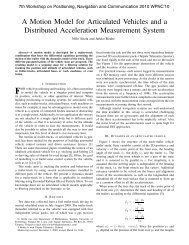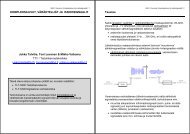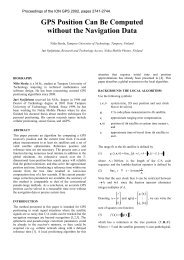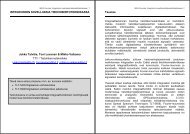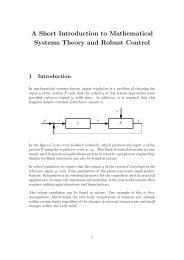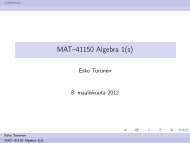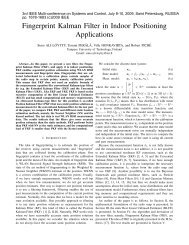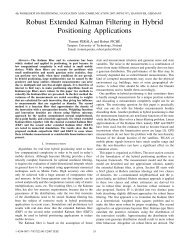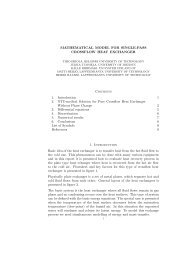Antti Lehtinen Doppler Positioning with GPS - Matematiikan laitos
Antti Lehtinen Doppler Positioning with GPS - Matematiikan laitos
Antti Lehtinen Doppler Positioning with GPS - Matematiikan laitos
You also want an ePaper? Increase the reach of your titles
YUMPU automatically turns print PDFs into web optimized ePapers that Google loves.
equations in the system of equations 3.5. Physically this means pseudorange<br />
measurements from at least four different satellites at the same time. If there<br />
are more than four equations, the methods developed for solvingoverdetermined<br />
systems of equations may be applied.<br />
3.3.2 Solution Procedure<br />
There are numerous methods for solvingthe system of equations 3.5. Both closedform<br />
and iterative solutions have been extensively studied. A good overview of<br />
different methods is provided in [Korvenoja, pp. 31-50]. Here we will introduce<br />
the most commonly used method, namely the iterative least squares algorithm.<br />
For notational simplicity, let us denote the user position and time vector as<br />
n =[xuyu zu ctu] T where xu, yu, zu are the user x, y, z coordinates, respectively,<br />
c is the speed of light and tu is the user clock bias. Moreover, let us<br />
denote the estimated user position and time vector as ˆn = T ˆxu ˆyu ˆzu c ˆtu .The<br />
expected pseudorange is denoted by ˆρi and is the theoretical pseudorange calculated<br />
assuming n = ˆn. With the pseudorange model 3.2 one has the expected<br />
pseudorange as a function of ˆn<br />
ˆρi =ˆρi(ˆn) =ri − ˆru + c ˆtu<br />
(3.6)<br />
Usingthe vector notation, we have the pseudorange measurement vector ρ =<br />
[ρ1 ρ2 ... ρn] T and the expected pseudorange vector ˆρ =[ˆρ1 ˆρ2 ... ˆρn] T<br />
Usingthe first order Taylor series, one can approximate the theoretical pseudorange<br />
vector ˆρ at any point ˆn + △n:<br />
ˆρ (ˆn + △n) =ˆρ (ˆn)+ ∂ˆρ<br />
△n (3.7)<br />
∂ ˆn<br />
where n is the linearization point and △n is an arbitrary vector. Naturally, the<br />
approximation 3.7 is most accurate when △n is small.<br />
Obviously, the ultimate purpose of the algorithm is to find the receiver’s position.<br />
Thus, the user needs to find a correction term △n such that the theoretical<br />
pseudoranges match the measured ones. This can be achieved by setting the<br />
right hand side of the equation 3.7 to equal ρ:<br />
ˆρ (ˆn)+ ∂ˆρ<br />
△n = ρ (3.8)<br />
∂ ˆn<br />
Now the equation 3.8 can be solved. Accordingto [Kaplan, p. 521], the least<br />
squares solution for the correction term is<br />
△n = −<br />
∂ˆρ<br />
∂ ˆn<br />
T ∂ˆρ<br />
∂ ˆn<br />
12<br />
−1 T ∂ˆρ<br />
(ˆρ − ρ) (3.9)<br />
∂ ˆn




